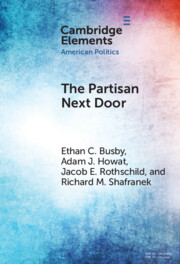Element contents
The Partisan Next Door
Published online by Cambridge University Press: 16 September 2021
Summary
Information
- Type
- Element
- Information
- Series: Elements in American PoliticsOnline ISBN: 9781009086462Publisher: Cambridge University PressPrint publication: 07 October 2021
